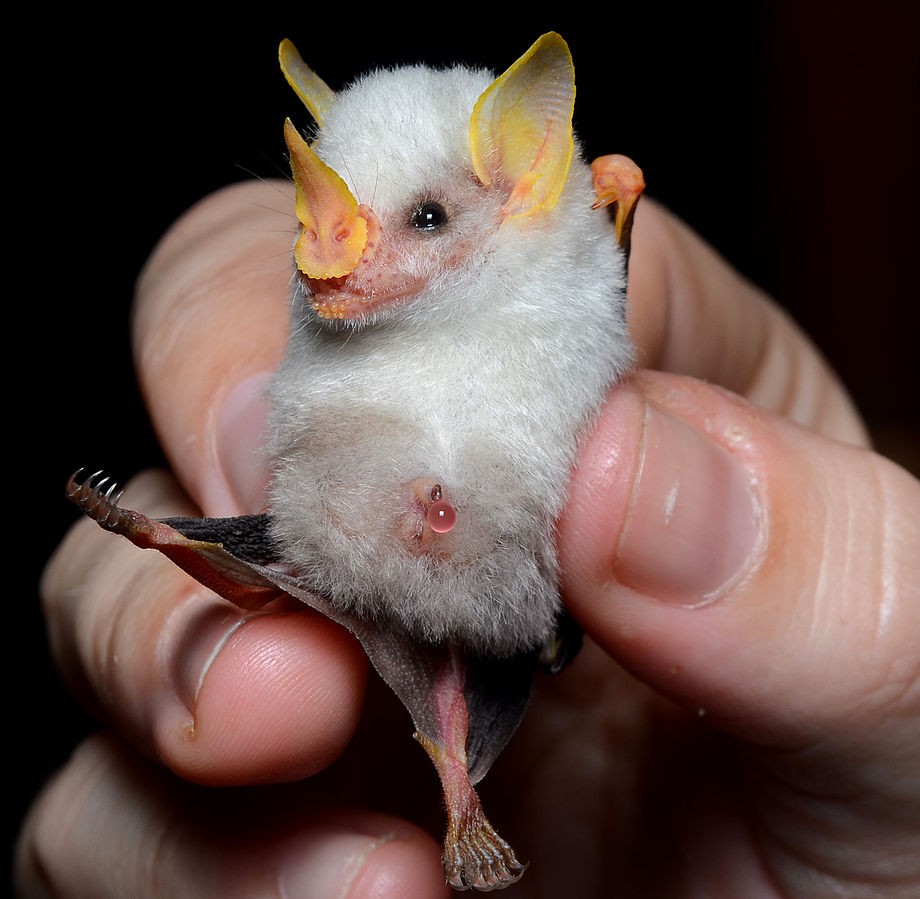Honduran white bat
A species of Honduran white bats, Also known as White tent-making bat, Central american white bat Scientific name : Ectophylla alba Genus : Honduran white bats
Honduran white bat, A species of Honduran white bats
Also known as:
White tent-making bat, Central american white bat
Scientific name: Ectophylla alba
Genus: Honduran white bats
Content
Description People often ask General Info
Description
Like both its common name and specific epithet suggest, the Honduran white bat has bright white fur. The tips of individual hairs are gray, with the grayish coloration more pronounced towards the bat's posterior. This species, along with four Diclidurus species and the ghost bat (Macroderma gigas), is among the only currently known species of bat—more than 1,300 species have been described—where the pelage is all white. Its large nose-leaf easily distinguishes it from the northern ghost bat (Diclidurus albus), however, which is the only white bat with which it is sympatric (having an overlapping geographic range). Its wing membranes are black. Its ears, tragi (the cartilaginous projections in front of the ear openings), nose-leaf, and lips are a bright, yellowish orange. Its yellow-orange pigmentation is due to large concentrations of carotenoids, particularly xanthophyll. It is the first mammal known to have enough carotenoids in its skin to generate conspicuous color. A 2019 study found that while the brightness of the yellow pigment of the ears did not vary significantly between adults and juveniles, the yellow chroma (colorfulness relative to brightness) of the ears did differ with age. Adult bats had higher yellow chroma in their ears than did juveniles. The yellow of the nose-leaf, however, had more variation. Adult males' nose-leaves are a brighter yellow than those of adult females; juveniles of each sex did not differ in nose-leaf brightness. Adult males also had significantly brighter nose-leaves than juvenile males. Similarly to the ears, the yellow chroma of the nose-leaf was greater in adults than in juveniles, though not different between the sexes. The authors suggested that the color difference of male and female nose-leaves is indicative of sexual dichromatism, meaning that females may select for males with brighter nose-leaves. This conclusion was supported by the trend that males with brighter yellow nose-leaves tended to have better body conditions. Females could thus use nose-leaf color as a metric of male fitness when selecting a mate. Another 2019 study found that the distinctive yellow pigment may have evolved as a result of the bat's tent-roosting. Reconstructions of ancestral states showed that the yellow coloration coevolved with tent-roosting. It is a small species, with a head and body length of 37–47 mm (1.5–1.9 in), a forearm length of 27.8–29.3 mm (1.09–1.15 in), and an ear length of 10–15 mm (0.39–0.59 in). Individuals weigh only 5–6 g (0.18–0.21 oz). The bat's nose-leaf is erect, its tail is absent, and its ears large and rounded. The inner margin of the tragus is convex, while the outer margin is coarsely serrated with four or five small lobes. The nose-leaf also has a serrated margin. It has eight to ten small "warts" under its mouth. Its dental formula is 2.1.2.22.1.2.2, for a total of 28 teeth. Its skull is similar in appearance to other species in its subfamily, with the exception of its very deep basioccipital pits. The bat overall resembles a small, white Platyrrhinus. 
People often ask
General Info
Lifespan
20 years
Diet
Honduran white bat is a predominantly frugivorous animal, with bananas and berries comprising a substantial part of its diet. Additionally, they ingest small insects and plant material occasionally, supplementing their fruit-based food intake.
Appearance
Honduran white bat is a small bat with a flat, disc-shaped body, covered in short, dense fur. Its predominant color is white, unique among bats, hence it's moniker, the 'ghost bat.' Its wings are broad and fingers elongated, supporting membranous flight skin. The tail is encapsulated within the uropatagium, a skin flap extending between the hind limbs. Differences in appearance due to age, gender, or subspecies are not prominent.
Behavior
Honduran white bat exhibits nocturnal foraging behavior, relying on its excellent echolocation to locate fruits. Predominantly monogamous and social, it forms small colonies with its mate and offspring. Unusually for bats, it constructs tents from leaves for shelter. This species displays roosting, a thermoregulatory behavior, to adapt to its rainforest habitat.
Population
Decreasing
Scientific Classification
Phylum
Chordates Class
Mammals Order
Bats Family
Leaf-nosed bat Genus
Honduran white bats Species
Honduran white bat 